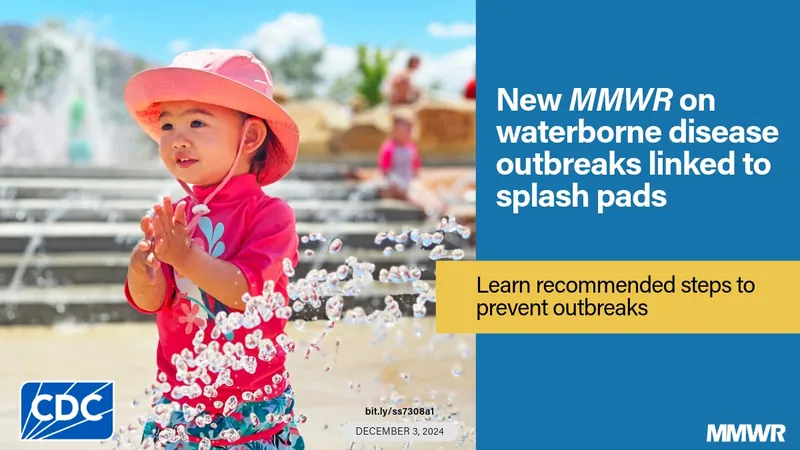
Splash Pad Safety at Risk: Shocking Surge in Waterborne Disease Outbreaks Across the U.S. (1997-2022)
2024-12-05
Author: Ting
Introduction
Splash pads – often referred to as water playgrounds, spray parks, or interactive fountains – have surged in popularity since their introduction in the 1990s as safe havens for children to play. Designed to eliminate standing water, they minimize drowning risks, but they come with hidden dangers. Data suggests a disturbing connection between these vibrant water attractions and waterborne disease outbreaks in the U.S., with reports spanning from 1997 to 2022.
The Alarming Link Between Splash Pads and Illness
Despite their safety designs, splash pads can still harbor risks for waterborne illnesses. The Centers for Disease Control and Prevention (CDC) has noted a troubling trend where splash pads have become associated with outbreaks linked to pathogens, indicating potential lapses in water sanitation practices. Many splash pads operate under outdated regulations, with only a handful of states implementing strict public health guidelines until recent years.
With officials in just 13 states regulating these venues before 2000, the connection between splash pads and public health is increasingly scrutinized, especially following a rise in cases attributed to poor maintenance of water quality systems.
Investigation and Data Collection
In an effort to tackle these issues, the CDC relies on extensive data collection via the Waterborne Disease and Outbreak Surveillance System (WBDOSS) – which was later enhanced by the National Outbreak Reporting System (NORS) launched in 2009. Through these platforms, states voluntarily report outbreaks, enabling public health officials to gather insights into the prevalence and causes of these concerning incidents.
Between 1997 and 2022, public health officials reported 60 splash pad-associated outbreaks across 23 states and Puerto Rico, accounting for over 10,600 reported cases. Shockingly, the likelihood of severe outcomes included 152 hospitalizations, underlining the serious impact of such outbreaks.
The Culprits Behind the Outbreaks: What We Know
Most troubling is the finding that Cryptosporidium, a chlorine-resistant pathogen that thrives in contaminated water, was responsible for 67% of these outbreaks. While chlorine plays a crucial role in keeping water safe, its effectiveness is compromised due to the parasite's resilience, allowing it to survive even in treated environments. High levels of Chlorine – the recommended protection against such pathogens – were insufficient in many cases due to the nature of splash pad operations that aerosolize disinfectants.
Epidemiological records also reveal that young children are particularly vulnerable, with infants and toddlers frequently mingling with pathogens due to inadequate managment of hygiene practices. Caregivers must be educated on the critical role they play in maintaining safety at splash pads, as poor practices often lead to disease transmission from children's fecal contamination.
Seasonality of Outbreaks: A Pattern Emerging
Analysis reveals that a staggering 95% of splash pad-related outbreaks occurred during the warmer months of May through August. This presents additional challenges for public health, as families flock to these venues during summer, intensifying the need for stringent safety measures and proper hygiene practices.
Behind the Scenes: Maintenance and Regulatory Challenges
Public health experts have urged for improved operations at splash pads. Findings suggest that many facilities are prone to failures in disinfectant levels due to operational lapses, such as inadequate monitoring and maintenance of water quality systems. Alarmingly, inspections across various states found that many splash pads operated without proper compliance to safety standards, often failing to maintain adequate chlorine levels.
Recent recommendations from the CDC have sought to address these shortcomings. Their 2023 Model Aquatic Health Code (MAHC) emphasizes the necessity for stringent design and operational protocols specifically tailored for splash pads. Solutions like innovative disinfection systems and regular water quality monitoring are key to mitigating risk.
Final Thoughts: The Role of Operators and Caregivers
Maintaining safe conditions for children at splash pads hinges on the diligence of operators and responsible behavior from caregivers. While regulatory measures are critical, the ultimate responsibility lies with those managing these fun-filled attractions and the families that frequent them. As outbreaks continue to threaten the safety of these vibrant venues, proactive measures, education, and community involvement are essential for safeguarding public health.
As we navigate this evolving landscape of splash pad safety, awareness of waterborne pathogens and adherence to rigorous health guidelines may be our best defense against another outbreak. Join the conversation and ensure your local splash pad is a safe place for laughter and play this summer!


 Brasil (PT)
Brasil (PT)
 Canada (EN)
Canada (EN)
 Chile (ES)
Chile (ES)
 España (ES)
España (ES)
 France (FR)
France (FR)
 Hong Kong (EN)
Hong Kong (EN)
 Italia (IT)
Italia (IT)
 日本 (JA)
日本 (JA)
 Magyarország (HU)
Magyarország (HU)
 Norge (NO)
Norge (NO)
 Polska (PL)
Polska (PL)
 Schweiz (DE)
Schweiz (DE)
 Singapore (EN)
Singapore (EN)
 Sverige (SV)
Sverige (SV)
 Suomi (FI)
Suomi (FI)
 Türkiye (TR)
Türkiye (TR)